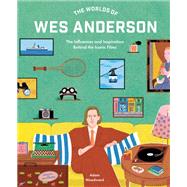
The Worlds of Wes Anderson The Influences and Inspiration Behind the Iconic Films
by Woodward, Adam-

Free Shipping On Orders Over $35
Your order must be $35 or more to qualify for free economy shipping. Marketplace items, eBooks and apparel do not qualify towards the $35 purchase minimum.
-
 eCampus.com Device Compatibility Matrix
eCampus.com Device Compatibility Matrix
Click the device icon to install or view instructions
Buy New
Rent Book
Rent Digital
Used Book
We're Sorry
Sold Out
How Marketplace Works:
- This item is offered by an independent seller and not shipped from our warehouse
- Item details like edition and cover design may differ from our description; see seller's comments before ordering.
- Sellers much confirm and ship within two business days; otherwise, the order will be cancelled and refunded.
- Marketplace purchases cannot be returned to eCampus.com. Contact the seller directly for inquiries; if no response within two days, contact customer service.
- Additional shipping costs apply to Marketplace purchases. Review shipping costs at checkout.
Summary
Anderson’s colorful and richly structured style is universally admired – but how has he managed to create such an enigmatic visual signature?
Like many key creatives, he’s found inspiration in a huge host of varied influences. From Hitchcock and Spielberg, to Truffaut and Varda, there are countless filmic homages and references scattered throughout Anderson’s filmography, while his cultural anchor points also go deep beyond film, and into the worlds of art and literature. Evocations of place and time also underpin his work, from mid-century Paris in The French Dispatch, to grand pre-war Europe in The Grand Budapest Hotel, while cultural institutions – such as Jacques Cousteau and The New Yorker magazine – are other touchstones.
For Wes Anderson fans and cinephiles alike, uncover the fascinating creative process of one of the world’s most revered filmmakers.
Author Biography
Adam Woodward is Editor-at-Large at Little White Lies magazine, the leading independent voice in film.
Table of Contents
Introduction
Chapter 1 Youth in Revolt
Part 1 Les quatre cents coups (François Truffaut, 1959)
Part 2 On the Waterfront (Elia Kazan, 1954)
Part 3 The British Invasion (1964–67)
Part 4 Melody (Waris Hussein, 1971)
Chapter 2 Forbidden Love
Part 1 The Graduate (Mike Nichols, 1967)
Part 2 Harold and Maude (Hal Ashby, 1971)
Part 3 The Passionate Friends (David Lean, 1949)
Part 4 A Story from Chikamatsu (Kenji Mizoguchi, 1954)
Chapter 3 Family Values
Part 1 The Magnificent Ambersons (Orson Welles, 1942)
Part 2 Charulata (Satyajit Ray, 1964)
Part 3 Tokyo Story (Yasujiro Ozu, 1953)
Part 4 Husbands (John Cassavetes, 1970)
Chapter 4 Under Authority
Part 1 La grande illusion (Jean Renoir, 1937)
Part 2 Torn Curtain (Alfred Hitchcock, 1966)
Part 3 L’enfance nue (Maurice Pialat, 1968)
Part 4 La chinoise (Jean-Luc Godard, 1967)
Chapter 5 Great Escapes
Part 1 Badlands (Terrence Malick, 1973)
Part 2 The Last Detail (Hal Ashby, 1973)
Part 3 Le monde du silence (Jacques-Yves Cousteau, Louis Malle, 1956)
Part 4 Paper Moon (Peter Bogdanovich, 1973)
Chapter 6 Creature Comforts
Part 1 My Neighbor Totoro (Hayao Miyazaki, 1988)
Part 2 Kes (Ken Loach, 1969)
Part 3 Fantastic Mr Fox (Roald Dahl, 1970)
Part 4 Watership Down (Martin Rosen, 1978)
Chapter 7 Life and Death
Part 1 Ikiru (Akira Kurosawa, 1952)
Part 2 Vagabond (Agnès Varda, 1985)
Part 3 Quai des Orfèvres (Henri-Georges Clouzot, 1947)
Part 4 Pigs and Battleships (Shôhei Imamura, 1961)
Chapter 8 Character and Perspective
Part 1 Stefan Zweig, selected works
Part 2 Barry Lyndon (Stanley Kubrick, 1975)
Part 3 Mean Streets (Martin Scorsese, 1973)
Part 4 The Red Shoes (Michael Powell, Emeric Pressburger, 1948)
Chapter 9 Colour and Composition
Part 1 Pieter Bruegel the Elder, selected works
Part 2 Mark Rothko, selected works
Part 3 Jacques Henri Lartigue, selected works
Part 4 Close Encounters of the Third Kind (Steven Spielberg, 1977)
Viewing Recommendations
Wes Anderson Filmography
Index
Image Credits
Biographies and Author Acknowledgements
An electronic version of this book is available through VitalSource.
This book is viewable on PC, Mac, iPhone, iPad, iPod Touch, and most smartphones.
By purchasing, you will be able to view this book online, as well as download it, for the chosen number of days.
Digital License
You are licensing a digital product for a set duration. Durations are set forth in the product description, with "Lifetime" typically meaning five (5) years of online access and permanent download to a supported device. All licenses are non-transferable.
More details can be found here.
A downloadable version of this book is available through the eCampus Reader or compatible Adobe readers.
Applications are available on iOS, Android, PC, Mac, and Windows Mobile platforms.
Please view the compatibility matrix prior to purchase.

